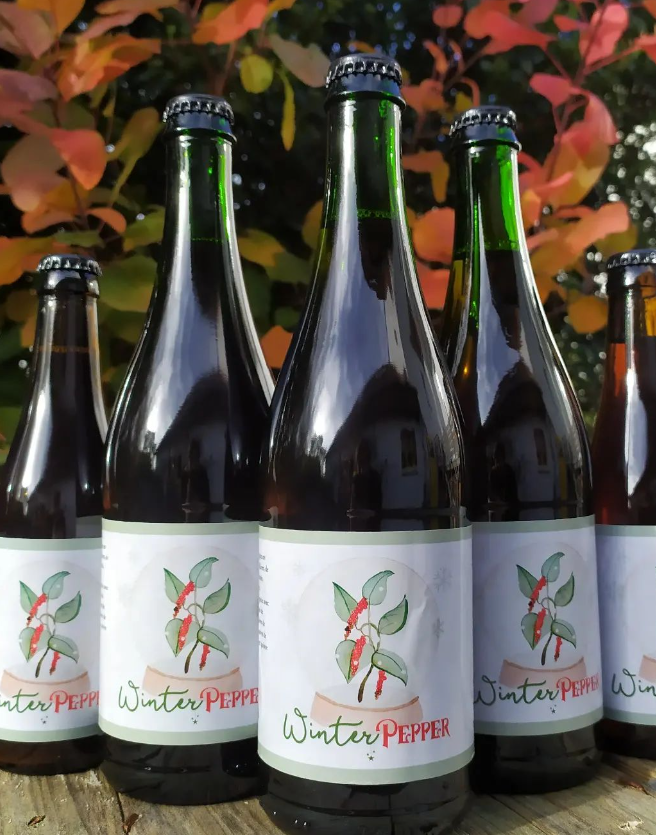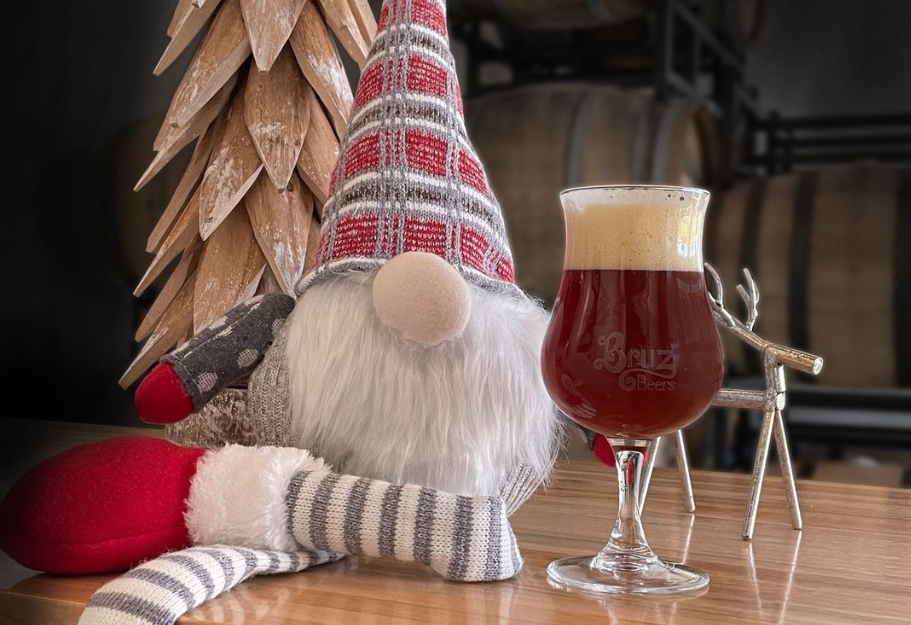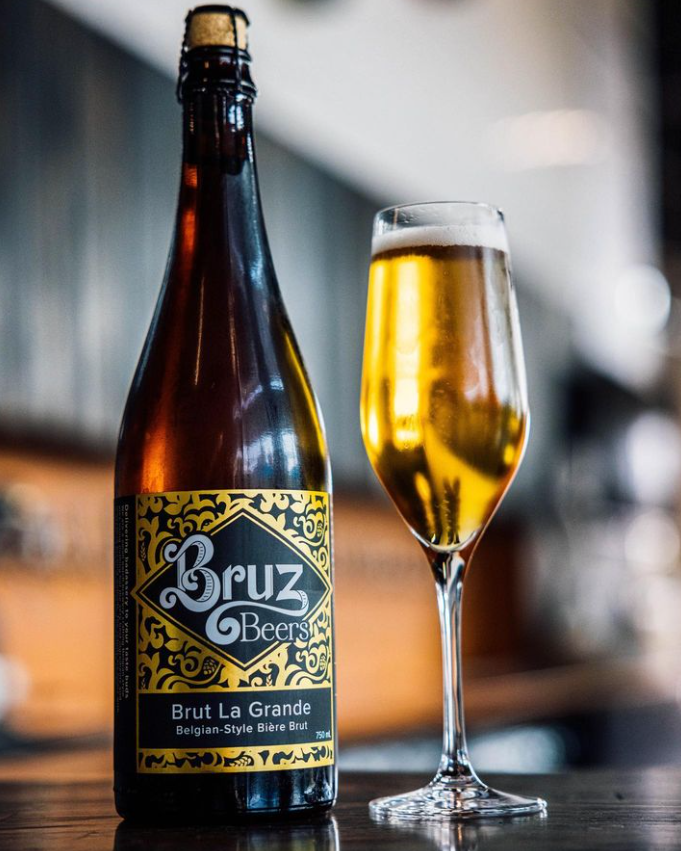by Ryan Pachmayer & Sachin “Chino” Darji
November typically heralds the arrival of Biere de Noel, or Christmas beer, on store shelves. Charlie Gottenkieny, co-founder of Bruz Beers in Denver and two-time AHA Homebrewer of the Year, explains that the modern style harks back to a special beer that brewers offered to their patrons each holiday season, usually with a stronger-than-typical punch. Christmas beers are not always high ABV beers bombs however, and its not uncommon for a brewery to make their holiday offering special by bumping up the flavor and alcohol on their flagship beer. “On the continent they started spicing them,” explains Gottenkieny, but “less so in England,” where holiday beers tend to be maltier and stronger than their everyday pints, old ales and British strong ales that are often called winter warmers. Consistent with their brewing culture, American brewers tend to spice their Noel beers with a heavier hand and bolder flavors than the Belgians do, setting up a trichotomy in world culture of holiday beers.
Bruz Beers released a whopping five Noel beers last season, running the gamut of those philosophies. A split batch of Belgian dubbel led off the series, one getting gingerbread spices and the other chai spice.
Next came the American/Nordic-inspired tipple, “Le Rudolph”, an unfiltered, dry hopped kveik-IPA refermented with Lingonberries. Bruz then went traditional with a lightly spiced quadrupel, appropriately named “Biere de Noel”. “We were drinking [this one] until June,” Gottenkieny adds with a laugh, renaming it to “spiced quad” to create a resurgence in sales. Breweries often avoid terms like “Christmas” or “Noel”, which can make identifying these seasonal treats difficult. In line with this, the capstone of Bruz’s Noel series was “Brut”, at 12% ABV it was the strongest beer in the series, a Champagne-like beer that Gottenkieny started making as a homebrewer, sometimes clocking in over 20% alcohol by volume. It became a patron favorite with complex, fruit-forward aromas and flavors, enhanced by high carbonation and a bone-dry finish.
This sort of creativity is not atypical in holiday beers, even in normally-staid Europe. In Northern
 France, Daniel Thiriez has been making beer at Brasserie Thiriez for over twenty-five years. “There’s no real style, but most of the time locally, the beer is dark, using caramel or chocolate malt, to create a warm, full bodied beer,” reveals the famed French master brewer. “Most of the time we use spices. Tradition here is to use cinnamon, cloves and orange peel, but this year I’ve decided to change, to do something different, with peppers.” Thiriez notes that Noel beers can be pale or amber, and it is typical for Belgian breweries to develop a variation of a flagship beer, making it stronger with distinctive additions to make it special.
France, Daniel Thiriez has been making beer at Brasserie Thiriez for over twenty-five years. “There’s no real style, but most of the time locally, the beer is dark, using caramel or chocolate malt, to create a warm, full bodied beer,” reveals the famed French master brewer. “Most of the time we use spices. Tradition here is to use cinnamon, cloves and orange peel, but this year I’ve decided to change, to do something different, with peppers.” Thiriez notes that Noel beers can be pale or amber, and it is typical for Belgian breweries to develop a variation of a flagship beer, making it stronger with distinctive additions to make it special.
Although the advent of the Christmas holiday came in 4th century Rome, the history of Christmas beer probably begins in the middle of the 10th Century C.E., when every household in Norway was mandated to brew a beer for the Jul holiday. This was formalized in the Gulating Code. Toward the end of the first Millenium, King Olaf Tryggvason merged pagan traditions of this juleøl beer around the winter solstice with Christian customs. Even today, Norway is obsessed with this dark, rich, strong ale around the winter holidays.
The United States also had a now-lost history of Christmas beer. Prior to the consolidation of the beer industry, the largely German base of brewers brought the tradition of Christmas bockbier with them. Many breweries back then brewed a bock or other special beer, which was offered only to distributors, employees, and other friends. Over time, these beers were also offered to customers. The most famous of these is Ballantine’s Burton Ale, which was brewed as a Christmas beer into the 1950s.
In terms of BJCP beer styles, Noel beers can fit appropriately into a variety of subcategories, depending on the beer. The obvious category for a classic, amber and malty beer with Christmas-type spicing is 30C. Winter Seasonal Beer. For beers that don’t hit those marks, holiday beers might fit in 30A. Spice, Herb or Vegetable Beer if the spicing isn’t typically of the holiday season, or 34C. Experimental Beer. Subcategory 27. Historical Beer could fit for something like a juleøl. Beyond those styles, brewers should consider base subcategories for entries, as well. For example, if a Noel offering is simply a stronger version of the house beer, it may fit best within the parameters of the base style.
The world of holiday beers is wide and wild, and doing justice to the history, traditions, styles, and – creativity is a book-length proposition. You can taste Biere de Noel examples around the world these days, bearing various names such as Christmas beer, Noel, holiday beer, winter ale, winter warmer, and more. Anchor Brewing’s Our Special Ale is a beer with a cult following that changes its recipe annually. Deschutes Jubelale is a winter ale that gets complexity from the five different malts and five different hops in the beer. Chicago-based Revolution’s Fistmas is unique in being red ale, with ginger and orange peel. Notable beers from across the pond include St. Bernardus Christmas Ale, a beer you can find throughout the United States. An absolute classic from the Continent is Brasserie Dupont Avec Les Bons Voeux, with prominent flavors of clove, hazelnut, citrus, and banana, despite not actually using any fruit or herbs. From Austria via Switzerland, Brauerei Schloss Eggenberg’s Samichlaus Classic potent, amber nectar harkens back to Christmas bocks. Finally, Brouwerij Het Anker, in Northern Belgium, brews Gouden Carolus Noel, a spiced version of its Carolus Classic dark strong.
If you are looking for something special and unique to provide some cheer this holiday season, be sure to fill your glass with some Biere de Noel, by whatever name it may come!
Ryan Pachmayer is a certified judge and beer writer residing in Arvada, Colorado. He covers beer for Denver’s Westword Magazine and is a frequent contributor to Zymurgy Magazine. Ryan is also the head brewer at Yak & Yeti Restaurant and Brewpub and the Marketing Director at New Image Brewing. He can be found on Instagram @ryanofcolorado.
Sachin “Chino” Darji started homebrewing over 25 years ago. He is the moderator of the homebrewing subreddit at reddit.com, a multiple-times presenter at Homebrew Con and an author of homebrewing articles. He pioneered the “Chino Cannon,” among other homebrewing innovations.



